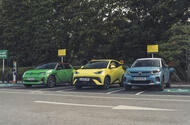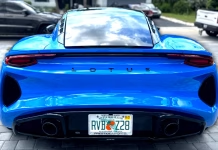UK New Car Sales Dip as Buyers Await Electric Car Grant Clarity and Price...
 Industry expects demand to pick up as more EVs are declared eligible for the ECG
Industry expects demand to pick up as more EVs are declared eligible for the ECG
The UK registered 5% fewer cars in July than in the same month last year, as the EV market stalled while buyers awaited clarity on which electric cars will be eligible for new government grants.
Some 140,000 new cars were registered last month, a dip that ended a two-month period of growth, but the industry is optimistic that the announcement of new government- and manufacturer-backed discounts for EVs will accelerate uptake and drive an increase in sales, and it is now expected the UK will register 1.9 million cars in 2025.
Growth in electric car sales slowed dramatically in July as customers waited to see which cars would be eligible for the government's new Electric Car Grant (ECG), which will reduce the price of some sub-£37k EVs by either £1500 or £3750, according to various criteria.
Registrations of pure-EVs were up 9.1% in July compared with the same month last year, to 29,825 units. That's significantly down on the 34.6% uptick in demand recorded over the first half of 2025 and made it the second weakest month of the year so far for EV registrations after April, when changes to car tax rules "distorted the market", according to the Society of Motor Manufacturers and Traders (SMMT).
News of the latest car sales figures, though, comes on the same day that the government has confirmed the first EVs eligible for the ECG will be Citroën's ë-C3, ë-C3 Aircross, ë-C4, ë-C4 X, ë-Berlingo and new ë-C5 Aircross - each eligible for the lower of the two discounts and so now £1500 cheaper at the point of sale.
The SMMT says further clarity on the models eligible for the grant, expected over the coming weeks, will be crucial as EV sales are still lagging well behind the trajectory of the zero-emission vehicle (ZEV) mandate. Currently, battery-electric vehicles (BEVs) hold a 21.3% market share, which is well behind the 28% EV mix manufacturers must achieve in 2025, "demonstrating the importance of accelerating uptake over the remainder of the year", said the SMMT.
However, as consumers await further confirmation of which cars and manufacturers will attract the ECG – a decision that hinges largely on the emissions of the country of manufacture – many brands have already started to slash prices themselves in a bid to shift EVs.
Alfa Romeo, MG, Volvo and Smart, for example, are among the makers who have applied £1500 discounts to some of their sub-£37k EVs, while cars including the Leapmotor C10, Hyundai Inster and GWM Ora 03 are now available with up to £3750 off.
SMMT boss Mike Hawes said July's figures lay bare "the new car market's sensitivity to external factors and the pressing need for consumer certainty".
He added: "Confirming which models qualify for the new EV grant, alongside compelling manufacturer discounts on a huge choice of exciting new vehicles, should send a strong signal to buyers that now is the time to switch. That would mean increased demand for the rest of this year and into next, which is good news for the industry, car buyers and our environmental ambitions.”
July's EV decline is "expected to be temporary", said the SMMT, forecasting that EVs will account for 23.8% of the UK's forecasted 1.9 million new cars at the end of the year.
Elsewhere, sales of hybrids were down 10%, diesel's decline continued with another 7.9% drop – to just 8000 cars in July – and there was a 14.7% decrease in sales of pure-petrol cars, which accounted for 66,271 sales. Nevertheless, pure-combustion powertrains still make up more than half of the new car market.
Plug-in hybrids, meanwhile, are seeing something of a renaissance, with registrations up 33% to 17,489 - giving them an eighth of the UK market, and setting them on course to likely overtake other hybrids in the coming months.
There was a small uptick in business registrations, but as these accounted for fewer than 3000 cars in July, it was far outweighed by 3.2% and 6.5% dips in private and fleet registrations, respectively.
Lotus Emira Struggles to Sell Despite Stunning Looks and Low Miles

Tariffs Hit Home: Why Even American-Made Cars Aren’t Immune

Used Diesel Car Values Defy the Odds as New Supply Dries Up and Demand...
 The powertrain may be on the way out, but the value of some models have risen by more than 10%
The powertrain may be on the way out, but the value of some models have risen by more than 10%
The values of some used diesel cars are actually increasing despite the fading appeal of the powertrain in the new car market, say leading vehicle valuation experts.
In the first half of 2025, just 58,722 new diesels were registered, down 11.3% on 2024. This continues a decline that can be traced to 2017, amid the fallout from the Dieselgate scandal and concerns about future vehicle taxation and emissions penalties.
Diesel’s days appear numbered. Only a few car makers still produce diesel models – among them Audi, BMW and JLR (especially with the Defender) – and other types, such as petrol, hybrid and battery-electric vehicles, are experiencing rising demand.
For most diesel models, this is reflected in increased rates of depreciation, but, bucking this trend, some have actually increased in value over what they were worth a year ago.
For example, according to Cap HPI, a three-year-old diesel Honda HR-V with 60,000 miles is worth 11.3% more today than the same model was at the same point last year. In addition, the value of an equivalent Mercedes CLS has risen 8% and a Ford Mondeo 6.5%.
Explaining the figures, Dylan Setterfield, head of forecast strategy at Cap HPI, said: “There is still demand for diesel in the used market from both consumers and dealers, with fuel economy continuing to be a significant factor for high-mileage drivers.
“New [diesel] car volumes have been decreasing for some time, and this is translating into reduced used car volumes. We expect these reductions to be partially offset by the ongoing reduction in consumer demand and that prices will behave similarly to petrol [car prices] in the next few years.”
However, the market is experiencing wild valuation extremes and some models are instead depreciating at higher than expected rates compared with what they were worth last year.
Those suffering the biggest falls in value include the Ssangyong Korando 2.2D, with a three-year-old example with 60,000 miles worth 24.5% less. An equivalent Vauxhall Astra is down 20.2% in value and a Range Rover Evoque down 12.7%.
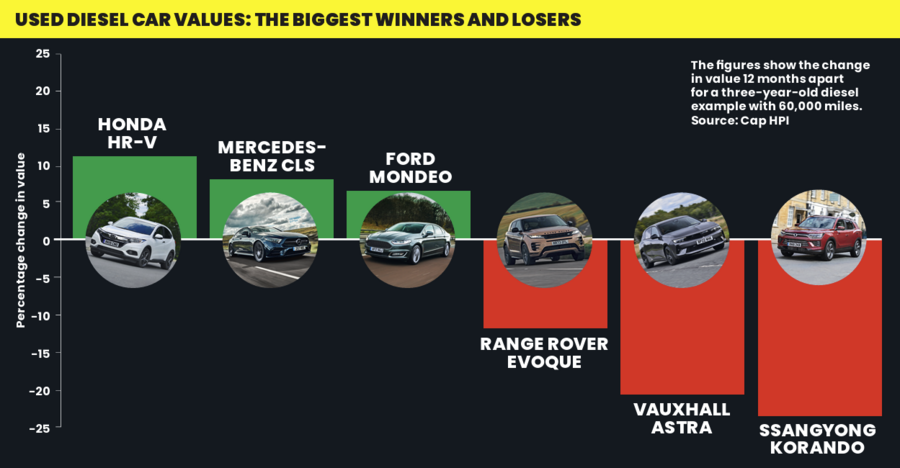
These losses are atop the models’ regular year-on-year depreciation. Setterfield said: “The Korando’s falls seem to have been caused by uncertainty and confusion in the marketplace as the brand transitioned from Ssangyong to KGM. Astra diesels with above-average mileage are now suffering increased penalties, while the Evoque’s figure can be explained by an increase in used volumes following a shortage of supply.”
Consumers unsure about buying a diesel are unlikely to be reassured by these wild extremes.
Fortunately, these cars aside, the bulk of the sector is actually quite stable, with the average three-year-old diesel worth just 2.1% less than its equivalent 12 months ago. The equivalent figure for a petrol car is 1.3% less.
At 12 months and 20,000 miles, their positions are reversed, with the diesel worth 1.4% less and the petrol 1.6% less.
Philip Nothard, insight director at Cox Automotive International, a vehicle auction and remarketing company, welcomed the return of stability to most areas of the diesel market.
He said: “After the highs of the immediate post-Covid years, when even two- to four-year-old diesels were worth 73% of their new price and ones less than a year old 98%, order is returning to the market. In 2023, diesel values fell at a steeper rate than petrol as sentiment shifted to the latter and, thanks to tax changes, to some extent also to EVs.
“The fall in the sales of new diesels that year means that today, there are only155,000 three-year-old diesels on the road. Values are sliding but just about holding firm, with two- to four-year-old diesels currently worth around 51% of their new price compared with petrol cars at 58%. Electric cars are worth around 36%.”
The shortage of used diesels and the stability of their values are reflected on dealer forecourts.
Motorpoint is a leading car supermarket and typically stocks around 5000 cars, most no older than four years. Currently, only around 350 of them are diesels and diesel hybrids. They include a 2023 Audi A4 35 TDI S Line S Tronic with 14,500 miles for £22,699 and a 2022 Ford Kuga 1.5 Ecoblue ST-Line X with 17,000 miles for £19,999.
Motorpoint Group CEO Mark Carpenter believes that although demand for diesels has fallen considerably, the declining number of new ones being produced means that used examples will soon be the only ones readily available to customers.
However, he doesn’t expect that any future increase in demand for them will necessarily trigger a steep rise in their prices.
He said: “While any uplift in demand for used diesel vehicles will have some impact on prices, with fewer new diesel cars on the road, used diesel stock will continue to get older, reducing its appeal for motorists wanting a nearly new car.”
BMW Speedtop Sells Out Instantly as Ultra-Rare Luxury Coupe Sets New Price Records
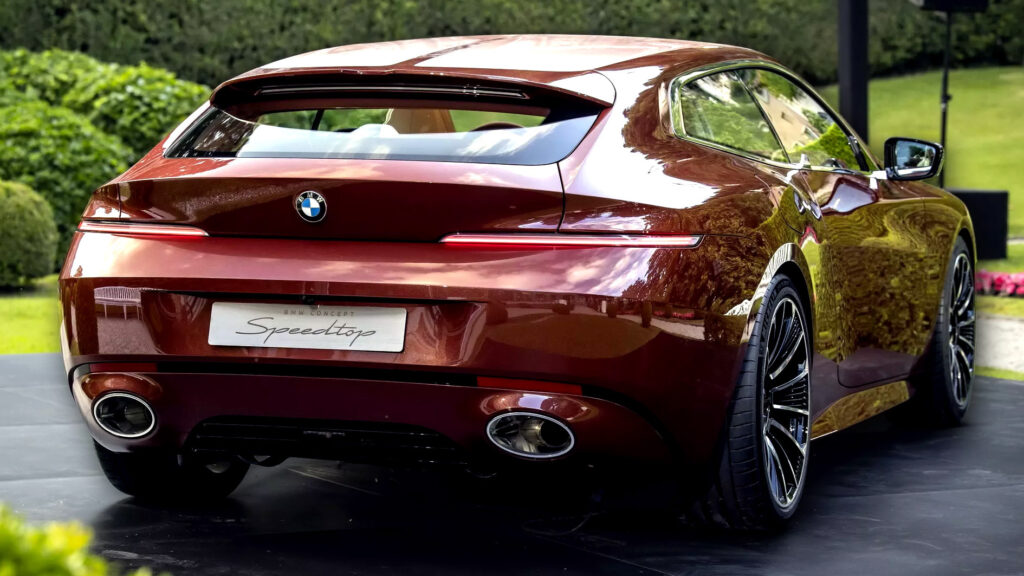
Nissan Juke Embraces Electric Future While Keeping Gas Power Alive
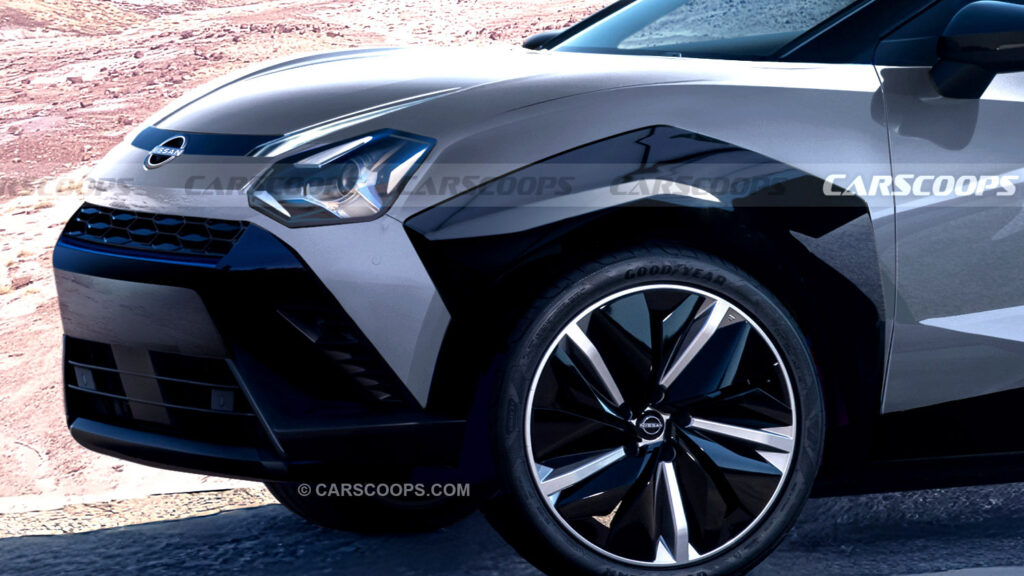
Electric Car Prices Slashed as Manufacturers Race to Offer Big Discounts Ahead of UK...
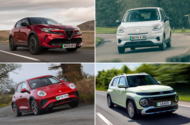 The new ECG was announced last month and will yield a discount on qualifying EVs of either £1500 or £3750
The new ECG was announced last month and will yield a discount on qualifying EVs of either £1500 or £3750
Car makers from Hyundai to Volvo are offering up to £3750 off new electric cars as they wait for the arrival of the UK government’s new Electric Car Grant (ECG).
Announced earlier this month, the ECG has been introduced as a way of stimulating EV sales in the UK, following a period of stagnation since the previous government’s Plug-in Car Grant (PiCG) was pulled in 2022.
The new ECG, backed by £650 million of government funding, will yield a discount for qualifying cars of either £1500 or £3750, depending on their environmental impact.
To qualify, car manufacturers themselves must meet science-backed emissions targets, while the individual model lines must start at below £37,000 in entry-level trim.
Which discount a model receives is determined by how much CO2 is emitted in an EV's production, assessing the energy used in vehicle assembly as well as battery manufacturing. Threshold levels have yet to be made public.
While any manufacturer can apply for their car to be included in the scheme, it's thought that, due to this criteria, cars produced in Asian countries, such as China, South Korea and Japan, will not be eligible for the ECG.
This would include cars from Hyundai, MG and GMW – all three of which have already launched their own equivalent discounts, likely pre-empting that their cars will be denied access to the ECG.
Below are the discounts already being offered by car makers as they await the results of the ECG applications.
Alfa Romeo
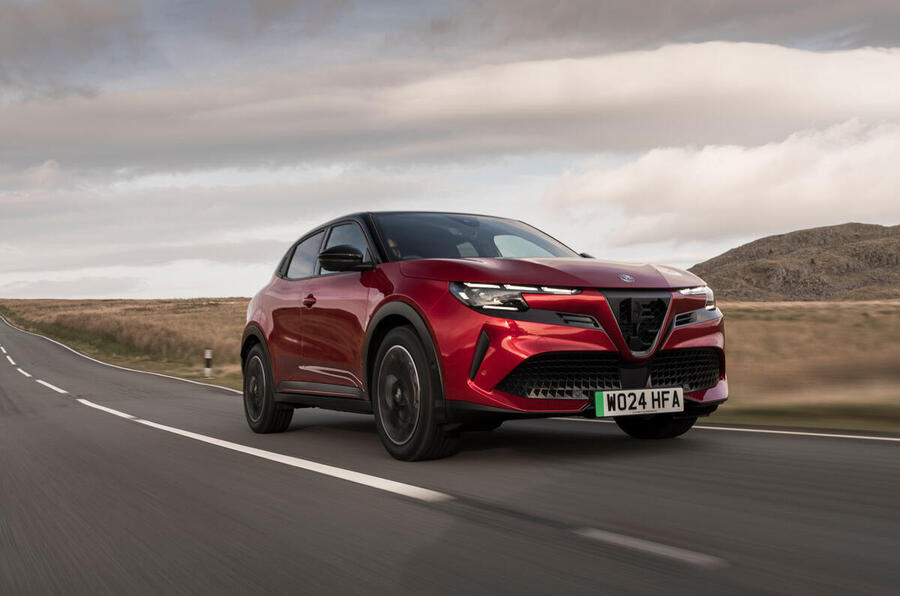
The Alfa Romeo Junior Elettrica – the Italian marque’s first EV – can now be had with £1500 off its list price. This leaves the Polish-made compact crossover retailing for £32,405.
Fiat

Italian car maker Fiat has brought back its £1500 'E-Grant' as it awaits its models eligibility decision. This discount is applied to the 500e, 600e and equivalent Abarth models. This drops pricing for the 500e to £23,535; the 600e to £28,535; the Abarth 500e to £28,485; and the Abarth 600e to £35,485. The upcoming Grande Panda Elettrica, which starts from £20,975, is not discounted.
GWM
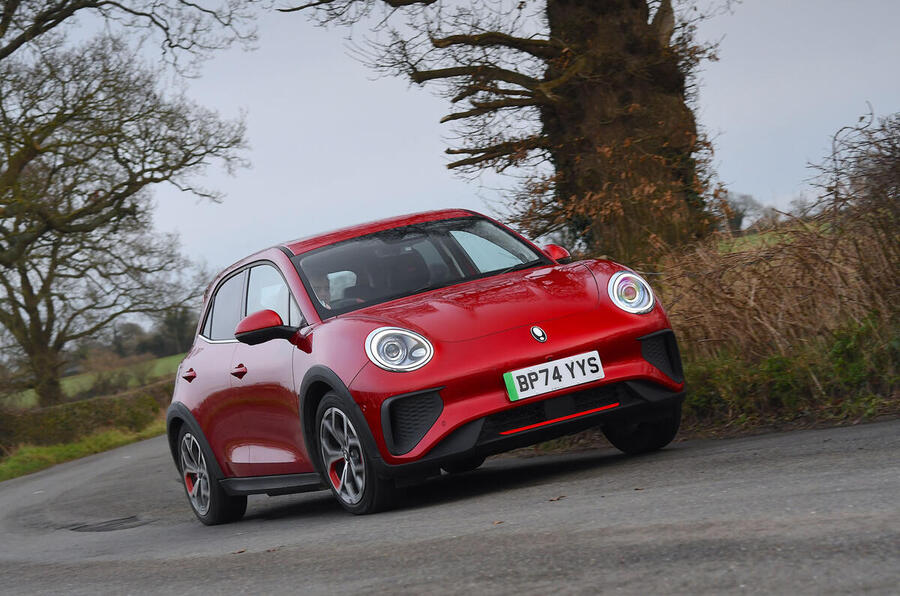
Chinese firm Great Wall Motor has launched a £3750 grant for the Ora 03 hatchback. The MG 4 EV rival, which was previously named the Funky Cat, now costs just £21,245.
Hyundai
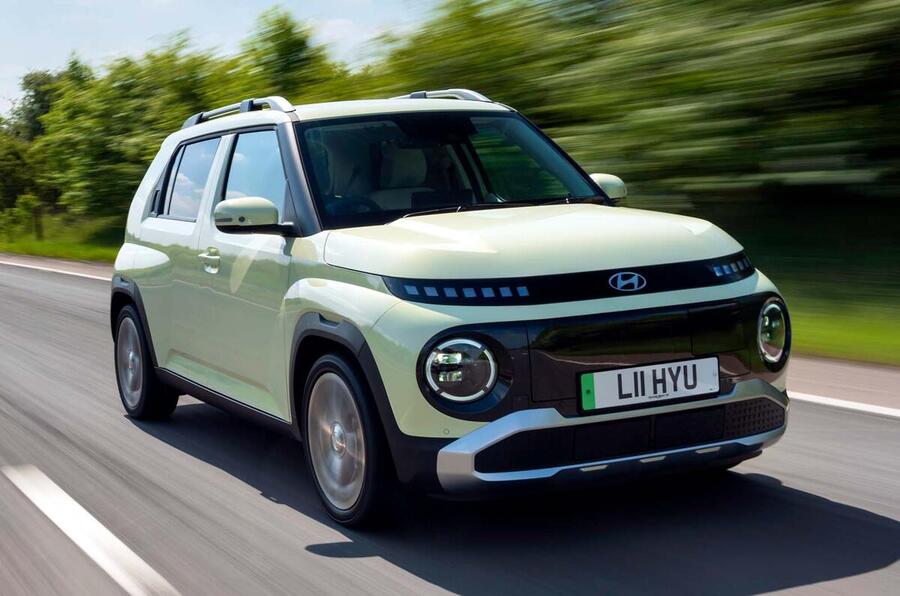
Hyundai is matching the government's incoming ECG by offering a discount of £3750 on its new Inster hatchback, bringing it down in price to £19,755. The prices of all its other EVs – such as the Ioniq 5, Ioniq 6 and Kona Electric – have been slashed by £1500.
MG

SAIC-owned Chinese brand MG has launched a discount of £1500 on its 4 EV hatchback and new S5 EV crossover. This brings down the price of the pair to £25,495 and £26,995 respectively.
Leapmotor
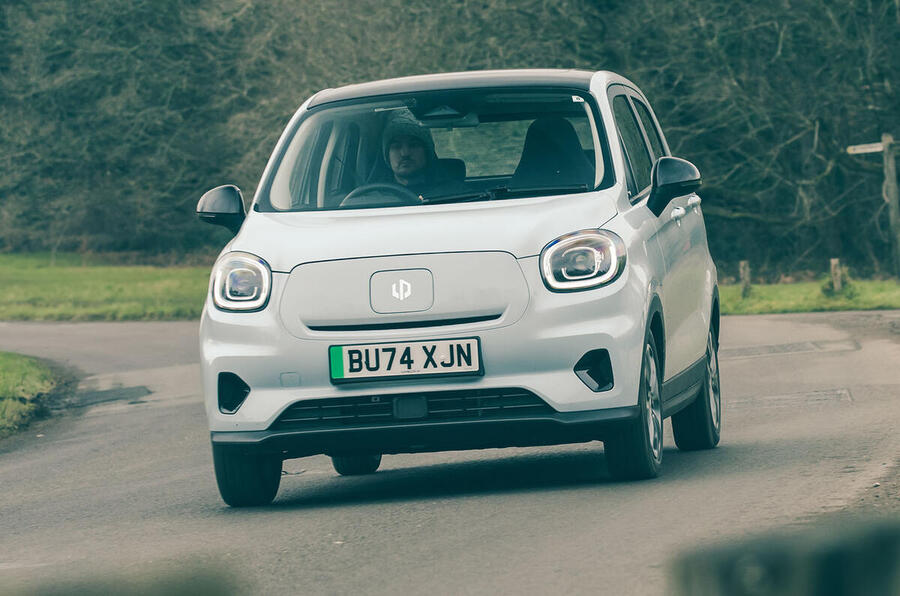
Stellantis brand Leapmotor has mirrored the government’s grant with two separate discounts. The Dacia Spring-rivalling T03 city car receives £1500 off, leaving it at £14,495, and the C10 SUV is discounted by £3750 to £32,750.
Skywell

One of the biggest discounts comes from the UK importer of Chinese brand Skywell. It's offering £3750 off its BE11 – the only car it sells in the UK – on top of a £6000 dealer contribution, meaning the £36,995 SUV can be driven away at £27,245.
Smart

Smart has added a £1500 discount on its #1 and #3 crossovers. This is applied on top of the existing manufacturer contribution of up to-£3000 for the #1 and up to-£2000 for the #3. After both discounts are applied, the #1 starts from £25,460 and the #3 from £30,460. Smart hasn't said if the new #5 SUV will be included in the discount when it arrives later this year.
Volvo

Volvo has lopped £1500 off the price of its EX30, EX40 and EC40 EVs. With that discount, the EX30 starts from £31,560, the EX40 from £44,760 and the EC40 from £50,410. No discounts are offered on the EX90 or ES90, though.
2026 Toyota Hilux Breaks Cover With Bold Redesign and High-Tech Interior Revolution

LA Woman Hit With $8,000 Parking Fee After 45-Minute Garage Visit

Nissan Taps Formula E Expertise to Supercharge Future Nismo Electric Sports Cars
 Electric racing team lined up to develop prototype versions of hot Nissan EVs
Electric racing team lined up to develop prototype versions of hot Nissan EVs
Nissan is considering using its Formula E team to develop prototype versions of hot EVs that could be used to help create future Nismo performance models.
Tommaso Volpe, Nissan’s Formula E team boss, told Autocar there are internal talks about how the Paris-based squad can aid the Nismo division in the development of future road-going electric performance cars.
The Japanese firm currently offers a warmed-up Nismo-badged version of the Ariya electric SUV, but company boss Ivan Espinosa previously told Autocar the firm had “exciting plans” for future sports cars, suggesting he wanted four or five halo models to top the line-up.
While he stressed plans had not been agreed yet, Volpe said a proposal was under consideration for the squad to develop “some prototypes based on normal chassis that can help the Nismo division to enhance the performance of electric cars”.
He added: “We have the Ariya Nismo now, which has no influence from Formula E, but we are considering a collaboration for future models. We could do a prototype version, then they could use that as a base to develop future products.”
Any future test mule is likely to be based around the twin-motor all-wheel-drive running gear of a Formula E racer and would be focused on helping Nismo learn about optimising the efficiency of electric performance cars and refining traction management with all-wheel-drive powertrains.
Notably, Formula E will introduce a new Gen4 technical package for the 2026/27 season. The regulations are set to feature powertrains with permanent all-wheel drive using a pair of motors to produce around 800bhp – up from the 469bhp of the current cars.
Volpe said the technology transfer in Formula E to date has generally gone from road car to race car, citing lines of Leaf software code used in the programming of the race car powertrain.
But he added that would switch with the new machines. “The development of the Gen4 cars will be when potential transfers will come from the racing cars to future [road] products, because the level of performance and efficiency will be pushed even more to the limit,” said Volpe.
“Also, they will be all-wheel-drive. With the Ariya we have strong expertise of all-wheel-drive electric powertrains and controlling the grip on four wheels independently. There is a huge possibility of transfer with our future products.
“The regulations of Gen4 have been written in an open conversation with manufacturers, and one of the reasons all-wheel drive is there is because of a strong push by Nissan and some other manufacturers, because all-wheel drive is the trend for the core business in the future.”

